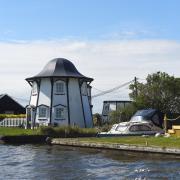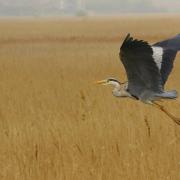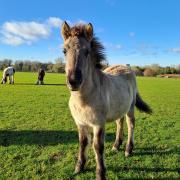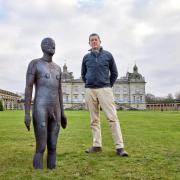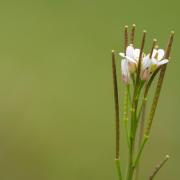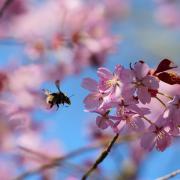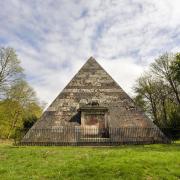We don’t often think about the ground beneath our feet, but soil is a miracle, says our columnist Nick. It is the place where geology, biodiversity, weather and atmospheric chemistry bind together to make the stuff of life.
Do you ever dig your hands into the soil, just for the simple pleasure of it? Just to be reminded of your childhood, when playing with soil was perfectly ok. Whenever I dig my hands into the soil, I can feel my fingers reaching down, stretching out like rootlets, planting me – geographically and emotionally – in my small place in the natural world. Like the fleeting weed I am.
We don’t think about soil enough. Not nearly enough. For soil is nothing less than miraculous. Nothing less than the flimsy, vulnerable medium for all terrestrial life on Earth. Including us.

For most of our lives, we act as if the soil sustaining us didn’t exist. It’s just the thing we stand on. Even then we’re usually separated from it by layers of concrete, tarmac, tiles and the rubber or leather of our soles. We do everything in our power to cleave ourselves from our mother soil. Which is odd as it’s where we come from and where – inescapably – each of us is bound.
So what is soil? It is the place where the Earth reaches for the atmosphere and the atmosphere reaches for the Earth. It is the place where geology, biodiversity, weather and atmospheric chemistry bind together to make the stuff of life. It is – I say it again – a miracle.
It’s an old place, Planet Earth. Some of the rocks we live on date back hundreds of millions – even billions – of years, unchanged. But most of the rocks we live on are prone to change, either melted by volcanic violence or worn away by water, wind and time. What’s worn away – the grit, the sand, the dust – makes up the mineral component of the soil.
But then it’s blessed by life. Life in all its dazzling and bewildering beauty. Healthy soil is the information superhighway of the natural world, bristling with bacteria, fungi, roots and micro-organisms, all sharing sugar, nutrients, water and – astounding as it seems to us – warnings and advice. Yes, scientists have shown that roots communicate not just nutrients but also information. The soil’s alive and – not to stretch the meaning of the word too far – intelligent.

We also know that soils – like the ecosystems which bloom from them above the ground – are healthiest and function best when given time. Everything we humans do to soils – ploughing, adding fertilisers, adding pesticides, harvesting root crops – reduces their ability to hold and manage water, reduces their biodiversity, reduces their ability to sequester carbon and – very often – releases the carbon they already hold. The soils which perform these vital functions best are those rare soils we leave alone. Even better if we leave them alone for centuries.
So nature conservation is a soil-deep matter. At Norfolk Wildlife Trust we understand that all the habitats and species we preserve depend on soil, on water and on climate. The remnant grassland of the Brecks – as at NWT Weeting and East Wretham Heaths – is precious on account of its well-drained sand, strewn over chalk by Ice Age glaciers. The grassland we protect at Ringstead Down is special because barely half an inch of fragile soil sits on top of Norfolk’s ancient chalk here. Foxley’s biodiversity is exceptional because the wood lies on the boundary between north Norfolk’s sand and south Norfolk’s chalky boulder clay. And the soil in all these places – thin or deep, dry or damp, alkaline or acid – has stood for centuries, largely undisturbed. It is an irreplaceable store of biodiversity: genes, organisms, communities of species and their interactions, and ecosystem services.
Just as we now know that our bodies contain more non-human cells than human, and that these billion inquilines are fundamental to our physical and mental health, so too science now teaches that the true diversity of terrestrial life – the chemical powerhouse sustaining every ecosystem – lies in the soil. Without countless unseen interactions in the soil, allowing plants to sequester carbon, release oxygen and manufacture carbohydrates, there would be no ecosystems; and none of the multicellular – beautiful but superficial – biodiversity which we humans cherish.
At Norfolk Wildlife Trust we have always taken care of soil. Since our foundation in 1926 we have bought or rented precious places which support the rarest species or the best examples of threatened ecosystems. Simply by doing this, we have preserved thousands of acres of ancient soils, with all their priceless living cargo. But perhaps not until the 1990s, as we began to restore Foxley Wood, did we truly understand the miracle of soil. Thirty years beforehand, most of Foxley Wood had been planted with conifers. Its ancient trees had been sprayed from a plane to kill them and – there being very little trade in firewood then – the dead trees dragged to pyres for burning. Thousands upon thousands of non-native conifers were then planted.

The wood, it seemed, was dead. But, after walking every inch of woodland, our warden realised that saplings of native broadleaved trees were trying to regenerate. Removing the conifers, he proposed, native trees could be allowed to flourish, creating a wood which – while nowhere near so complex as the wood which had been lost – was at least descended from it. What happened next was – again I use the word advisedly – miraculous. The soil of Foxley Wood – which had languished under conifers for thirty years – held the seeds of innumerable wildflowers which had seemed lost. Every single species recorded by the eighteenth-century vicar of nearby Lyng returned. Thanks to ancient soil.
These days we conservationists think in landscapes. And we know that critical to the restoration of wildlife across the Norfolk landscape is the restoration of our soil, in all its minuscule and miraculous wonder. For in healthy soil lie many of the answers to the climate and biodiversity crises we have engendered.
So go outside. Plunge your hands into the soil. Root yourself. And make yourself a promise to be an agent and an advocate for healthy soil, for all our sakes, forever.






